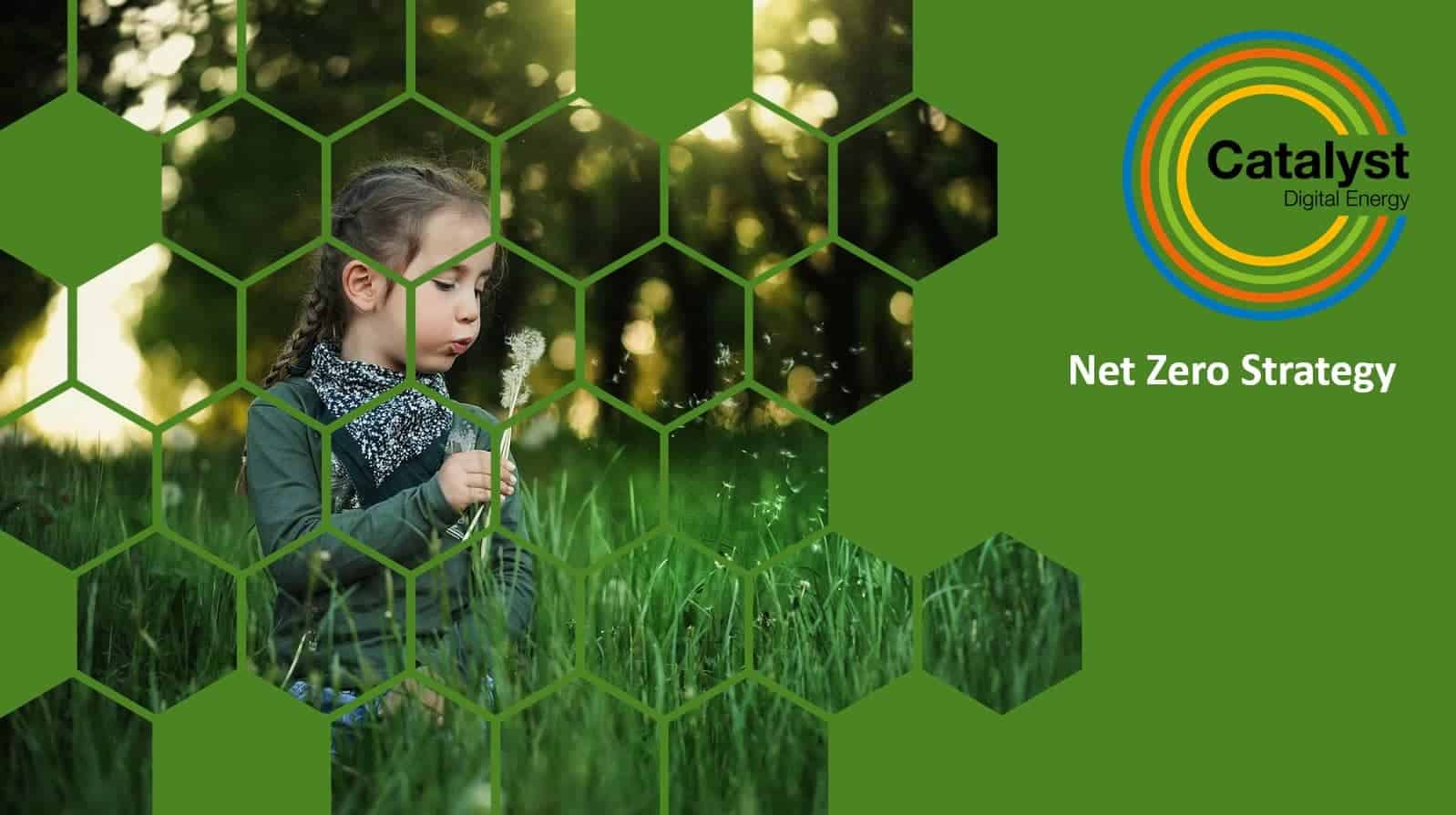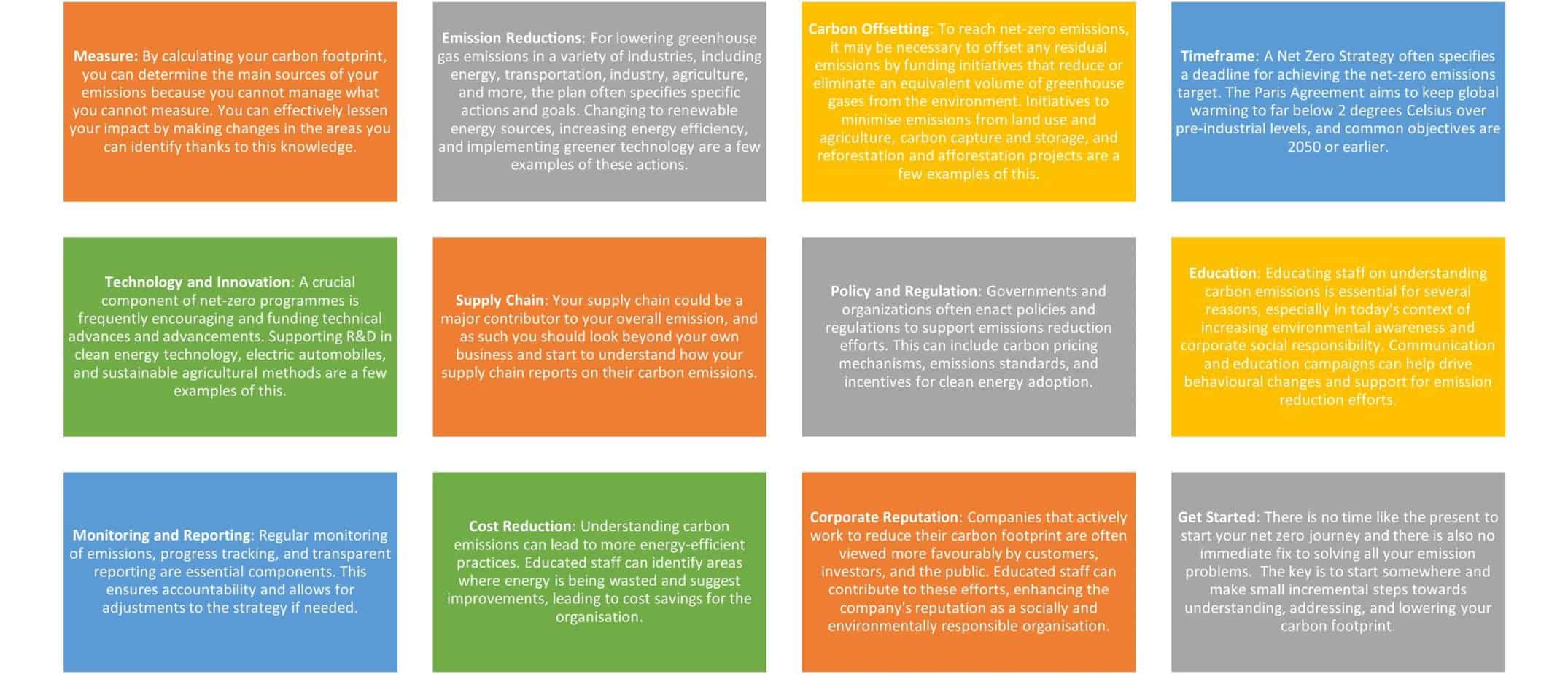Net Zero StrategyExplore how companies can accelerate progress toward net zero targets for 2030 and beyond.
A “Net Zero Strategy” typically refers to a comprehensive business plan or set of actions aimed at achieving net-zero greenhouse gas emissions. Net-zero emissions can only occur when the amount of greenhouse gases emitted into the atmosphere is balanced by the amount removed or offset. This results in no further net increase in the concentration of these gases. All of which is a critical goal in the global effort to combat climate change.
Many businesses recognise their contributing role to climate change through greenhouse gas emissions. As such they feel a sense of responsibility to address their own environmental impact and play a part in mitigating the effects of climate change.
With Governments and regulatory bodies already implementing stricter environmental regulations and emissions reduction targets for energy intensive organisations. It makes commercial sense for those not already included in such schemes, to understand and review their own carbon footprint, and identify a path to measure, monitor and reduce.
Net Zero strategies are increasingly important as the global community recognises the urgency of addressing climate change. Many countries, regions, cities, and corporations have announced their own net-zero commitments and developed carbon reduction strategies to achieve these goals, contributing to the broader effort to mitigate the impacts of climate change.

“Climate change isn’t just an environmental issue; it’s a people issue. It affects our homes, our food, our water, and our future. We should all be concerned because when the planet suffers, we all suffer. It’s time to take action and protect the world we love.”
What is a Net Zero Strategy
Our mission is simple: to help your business become a climate hero and make a positive impact on our planet. We believe that taking the first step in measuring your carbon footprint is the key to creating a sustainable future as you can’t manage what you can’t measure.
Step 1: Measure Your Carbon Footprint
> Why Measure – Before we can make any meaningful changes, we need to understand our impact. Think of it like checking your weight before starting a fitness program. Measuring your carbon footprint shows you how much greenhouse gas emissions you produce through activities like driving, using electricity, and many more additional categories.
> How to Measure – We have made it easy for you! Our consultative approach can work with you by explaining how to gather the required information and data, and how this data needs to be presented and then used for calculating your carbon footprint. Our user-friendly carbon footprint calculator will calculate your emissions and produce a report based on the various reporting requirements required.
> Why It Matters – Measuring your carbon footprint isn’t about blame; it’s about awareness. Once you know your impact, you can take steps to reduce it. Plus, you’ll be part of a global movement working toward a healthier planet for everyone.
Step 2: Set Your Net Zero Goal
> Your Target – Now that you know your starting point, it’s time to set a goal. Net Zero means your emissions balance out with emissions you offset or reduce elsewhere. Aim for a year when you want to reach Net Zero – maybe 2030, 2040, or 2050.
> Why Set a Goal – Goals give you direction and motivation. They help you focus on making changes in your business and inspire others to join the cause. It’s like having a treasure map to a greener future.
Step 3: Reduce and Offset Emissions
> Reduce Emissions – We always recommend starting with simple changes. Use energy-efficient appliances, drive less, and control more. Every small effort adds up to big results. It’s like turning off the tap while brushing your teeth to save water. Then you can start to review larger energy efficiency solutions such as onsite generation.
> Offset Emissions – For emissions you can’t eliminate (like driving), offset them by supporting projects that reduce greenhouse gases. It’s like planting trees to replace the ones you had to cut down for a treehouse.
Step 4: Track Your Progress
> Keep Score – You should annually check your carbon footprint to see how you’re doing. It’s like watching your plants grow; it’s rewarding to see your efforts pay off.
> Celebrate Achievements – Share your success with your customers and future prospects. Inspire them to join you on this green journey. It’s like throwing a party every time you reach a new milestone!
Conclusion: Join the Net Zero Movement!
Our Net Zero Strategy isn’t just about numbers: it’s about making a difference. By measuring your carbon footprint, you’re taking the crucial first step towards a sustainable future. Join us in this exciting adventure, and together, we can create a greener and cleaner world for generations to come.
How We Support Your Business on Its Path to Net Zero
From our own experience and delivering hundreds of projects with a focus on carbon reduction, we have a true experience of the steps needed to become net zero the right way and avoiding the common mistakes. In the face of climate change, businesses of all sizes are stepping up to the challenge of becoming more sustainable but often don’t know where to start or how to do it. At Catalyst we understand the importance of this journey, and we’re here to support your business every step of the way on its path to net zero.
1. Tailored Sustainability – Every business is unique, and so are the challenges they face in reducing their carbon footprint. Our approach is unique to each business and our sustainability consultations are uniquely tailored to your industry, size, and specific needs. Our carbon reduction consultants will analyse your current practices, identify areas for improvement, and develop a custom-tailored plan to help you reduce emissions and increase energy efficiency.
3. Transition to Renewable Energy – Transitioning towards renewable energy sources is a cornerstone of any net-zero strategy. Our energy consultants can guide you through the process of transitioning to clean energy options like solar, wind, batteries, and EV charging. From assessing the feasibility of on-site solar panels to helping you find reliable renewable energy suppliers; we can ensure a smooth transition to sustainable energy sources.
5. Employee Engagement and Education – We believe that a collective effort is essential in the journey towards net zero. Catalyst can assist you in engaging and educating your employees about sustainable practices. Through awareness campaigns, we empower your staff to understand what sustainability actually means and start making eco-conscious decisions both at work and in their personal lives. When everyone is on board, your business’s net-zero goals become achievable and sustainable.
2. Energy Efficiency Audits – Reducing your business emissions often begins with energy efficiency. Our skilled energy consultants can conduct comprehensive energy audits of your business operations combined with desktop data analysis to pinpoint energy-wasting practices and suggest practical no cost, low cost and return on investment solutions. From upgrading to energy-efficient appliances to implementing smart lighting systems. By optimising your energy usage, you not only reduce your environmental impact but also cut operational costs.
4. Carbon Offset Programs – For those difficult emissions that can’t be eliminated entirely, carbon offsetting is a powerful solution. We can connect you with verified or voluntary carbon offset programs that align with your business values. By investing in projects that remove or reduce greenhouse gases, such as reforestation initiatives or methane capture projects, you can balance out your remaining emissions and contribute to global climate action.
6. Transparent Reporting and Certification Support – We believe that transparency is key in demonstrating your businesses commitment to sustainability. As well as SECR standard carbon reporting and carbon reduction plans for all, we provide tools and support for transparently reporting your emissions reductions progress. Additionally, if you’re pursuing certifications like Carbon Neutral or B Corp, we offer guidance to streamline the certification process, ensuring your efforts are recognised and celebrated
At Catalyst we believe that sustainable businesses drive positive change. By partnering with us, you’re not only reducing your environmental impact but also strengthening your brand, increasing operational efficiency, and contributing to a healthier planet for future generations. Let’s work together to make your journey to net zero a reality. Together, we can build a more sustainable and prosperous future for all.
A Typical Net Zero Strategy
A complete plan or series of measures intended to achieve net-zero greenhouse gas emissions is generally referred to as a “Net Zero Strategy”. When the amount of greenhouse gases released into the atmosphere is equaled by the amount withdrawn or offset, there is no net rise in their concentration. This condition is known as net-zero emissions. This is an important objective in the global fight against climate change.

- Measure: By calculating your carbon footprint, you can determine the main sources of your emissions because you cannot manage what you cannot measure. You can effectively lessen your impact by making changes in the areas you can identify thanks to this knowledge.
- Emission Reductions: For lowering greenhouse gas emissions in a variety of industries, including energy, transportation, industry, agriculture, and more, the plan often specifies specific actions and goals. Changing to renewable energy sources, increasing energy efficiency, and implementing greener technology are a few examples of these actions.
- Carbon Offsetting: To reach net-zero emissions, it may be necessary to offset any residual emissions by funding initiatives that reduce or eliminate an equivalent volume of greenhouse gases from the environment. Initiatives to minimise emissions from land use and agriculture, carbon capture and storage, and reforestation and afforestation projects are a few examples of this.
- Timeframe: A Net Zero Strategy often specifies a deadline for achieving the net-zero emissions target. The Paris Agreement aims to keep global warming to far below 2 degrees Celsius over pre-industrial levels, and common objectives are 2050 or earlier.
- Technology and Innovation: A crucial component of net-zero programmes is frequently encouraging and funding technical advances and advancements. Supporting R&D in clean energy technology, electric automobiles, and sustainable agricultural methods are a few examples of this.
- Supply Chain: Your supply chain could be a major contributor to your overall emission, and as such you should look beyond your own business and start to understand how your supply chain reports on their carbon emissions.
- Policy and Regulation: Governments and organizations often enact policies and regulations to support emissions reduction efforts. This can include carbon pricing mechanisms, emissions standards, and incentives for clean energy adoption.
- Education: Educating staff on understanding carbon emissions is essential for several reasons, especially in today’s context of increasing environmental awareness and corporate social responsibility. Communication and education campaigns can help drive behavioural changes and support for emission reduction efforts.
- Monitoring and Reporting: Regular monitoring of emissions, progress tracking, and transparent reporting are essential components. This ensures accountability and allows for adjustments to the strategy if needed.
- Cost Reduction: Understanding carbon emissions can lead to more energy-efficient practices. Educated staff can identify areas where energy is being wasted and suggest improvements, leading to cost savings for the organisation.
- Corporate Reputation: Companies that actively work to reduce their carbon footprint are often viewed more favourably by customers, investors, and the public. Educated staff can contribute to these efforts, enhancing the company’s reputation as a socially and environmentally responsible organisation.
- Get Started: There is no time like the present to start your net zero journey and there is also no immediate fix to solving all your emission problems. The key is to start somewhere and make small incremental steps towards understanding, addressing, and lowering your carbon footprint.
